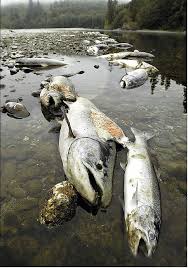Extreme weather killing fish by the thousands in the US
 August 6, 2012 – IOWA - Thousands of fish are dying in the central U.S. as the hot, dry summer dries up rivers and causes water temperatures to climb in some spots to nearly 100 degrees Fahrenheit (38 Celsius). About 40,000 shovelnose sturgeon were killed in Iowa last week as water temperatures reached 97 degrees Fahrenheit (36.1 Celsius). Nebraska fishery officials said they’ve seen thousands of dead sturgeon, catfish, carp, and other species in the Lower Platte River, including the endangered pallid sturgeon. And biologists in Illinois said the hot weather has killed tens of thousands of large- and smallmouth bass and channel catfish and is threatening the population of the greater redhorse fish, a state-endangered species. So many fish died in one Illinois lake that the carcasses clogged an intake screen near a power plant, lowering water levels to the point that the station had to shut down one of its generators. “It’s something I’ve never seen in my career, and I’ve been here for more than 17 years,” said Mark Flammang, a fisheries biologist with the Iowa Department of Natural Resources. “I think what we’re mainly dealing with here are the extremely low flows and this unparalleled heat.” The fish are victims of one of the driest and warmest summers in history. The federal U.S. Drought Monitor shows nearly two-thirds of the lower 48 states are experiencing some form of drought, and the Department of Agriculture has declared more than half of the nation’s counties — nearly 1,600 in 32 states — as natural disaster areas. More than 3,000 heat records were broken over the last month. Iowa DNR officials said the sturgeon found dead in the Des Moines River were worth nearly $10 million, a high value based in part on their highly sought eggs, which are used for caviar. The fish are valued at more than $110 a pound. Gavin Gibbons, a spokesman for the National Fisheries Institute, said the sturgeon kills don’t appear to have reduced the supply enough to hurt regional caviar suppliers. “We’re talking hundreds of thousands (killed), maybe millions by now,” Stephenson said. “If you’re only talking about game fish, it’s probably in the thousands. But for all fish, it’s probably in the millions if you look statewide.” Stephenson said fish kills happen most summers in small private ponds and streams, but the hot weather this year has made the situation much worse. “This year has been really, really bad — disproportionately bad, compared to our other years,” he said. –Physics
August 6, 2012 – IOWA - Thousands of fish are dying in the central U.S. as the hot, dry summer dries up rivers and causes water temperatures to climb in some spots to nearly 100 degrees Fahrenheit (38 Celsius). About 40,000 shovelnose sturgeon were killed in Iowa last week as water temperatures reached 97 degrees Fahrenheit (36.1 Celsius). Nebraska fishery officials said they’ve seen thousands of dead sturgeon, catfish, carp, and other species in the Lower Platte River, including the endangered pallid sturgeon. And biologists in Illinois said the hot weather has killed tens of thousands of large- and smallmouth bass and channel catfish and is threatening the population of the greater redhorse fish, a state-endangered species. So many fish died in one Illinois lake that the carcasses clogged an intake screen near a power plant, lowering water levels to the point that the station had to shut down one of its generators. “It’s something I’ve never seen in my career, and I’ve been here for more than 17 years,” said Mark Flammang, a fisheries biologist with the Iowa Department of Natural Resources. “I think what we’re mainly dealing with here are the extremely low flows and this unparalleled heat.” The fish are victims of one of the driest and warmest summers in history. The federal U.S. Drought Monitor shows nearly two-thirds of the lower 48 states are experiencing some form of drought, and the Department of Agriculture has declared more than half of the nation’s counties — nearly 1,600 in 32 states — as natural disaster areas. More than 3,000 heat records were broken over the last month. Iowa DNR officials said the sturgeon found dead in the Des Moines River were worth nearly $10 million, a high value based in part on their highly sought eggs, which are used for caviar. The fish are valued at more than $110 a pound. Gavin Gibbons, a spokesman for the National Fisheries Institute, said the sturgeon kills don’t appear to have reduced the supply enough to hurt regional caviar suppliers. “We’re talking hundreds of thousands (killed), maybe millions by now,” Stephenson said. “If you’re only talking about game fish, it’s probably in the thousands. But for all fish, it’s probably in the millions if you look statewide.” Stephenson said fish kills happen most summers in small private ponds and streams, but the hot weather this year has made the situation much worse. “This year has been really, really bad — disproportionately bad, compared to our other years,” he said. –Physics
No comments:
Post a Comment